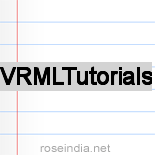VRML Tutorials
-
A Beginner's Guide to VRML
This document is intended to provide a ground level introduction to VRML (Virtual Reality Modeling Language) for those wanting to author VRML worlds for use on the internet. It intends to outline some basic concepts necessary to begin designing and authoring VRML worlds. It assumes that the reader has no background in 3D graphics, but has some familiarity with the internet and HTML. This document will then attempt to provide basic instruction in the creation of VRML worlds, and to list other resources which may be helpful to the aspiring VRML author.
-
The vruniverse
All the tutorials are original and tested. Please look for the symbols at the beginning of each section, e.g. 'WV2' stands for WorldView2 and 'CP2' stands for CosmoPlayer2. I focus on these VRML browsers mainly because I am too lazy to check other ones.All you need to start is a copy of the VRML specification, a text editor (SitePad), and of course a VRML plugin (WorldView or CosmoPlayer). Have fun and let me know whether you liked it.The VRML 2.0 Sourcebook is the Bible of VRML. All the nodes are explained with samples and the hypertext version is very useful. Late Night Vrml 2.0 with Java is the book of choice if you want to get into Java scripting. If you don't like the very technical VRML2.0 specification you might want to check out The Annotated VRML 2.0 Reference Manual
-
Floppy's VRML97 Tutorial
This page now covers 99% of the VRML spec. Part 1 introduces VRML and shows you how to create simple objects. Part 2 covers more advanced objects, and how to make them more realistic, while Part 3 covers animation and interaction, showing how you can make your worlds more exciting. Part 4 unleashes the power of VRML scripting with ECMAScript, bringing more complex behaviours to your worlds. Part 5 covers some even more complex scripting with Java, bringing the power of this fully-featured programming language to your worlds. The tutorial is an ongoing effort - if there is information missing, it's just because I haven't covered it yet :) The official version of this tutorial is at Floppy's Web3D Guide, at http://web3d.vapourtech.com/. If you're not looking at it there, it might have been updated since. Legal information related to acceptable use of this tutorial is laid out in the legal page of the main site. If you're considering redistributing this material, please read it.
-
VRML Audio Tutorial
The VRML 2.0 specification allows for the implementation of spatialized, 3D audio in a world. Spatial audio is sound that has been processed to give the listener a sense of the location of a virtual sound source in a virtual listening space. The process involves the use of Head-Related Transfer Function (HRTF) algorithms that mimic the way humans intercept and perceive sound, specifically the reflections off the pinnae (outer ear) and shoulder, as well as the shadowing effect of the head itself. This gives a heightened sense of immersion and realism in a virtual environment. The uses of spatial audio in a virtual world range from music and sound effects for entertainment to aural navigation for the visually impaired. As more uses for audio are implemented into virtual worlds, it will likely become as neccessary as graphics in order to create a quality experience.
-
The VRML Primers
A lot has happened since Mark and Tony first came up with the idea of a 3D interface to the Internet back in 1994. Since then that interface has evolved into a language and has been accepted as a good platform for creating 3D graphics on the Web. Now it's called VRML, or virtual reality modeling language.During these primers, you'll learn some basic concepts, probably download a browser, and get an introduction to the rest of the Microgoodies VRML tutorials. They've been designed to show you a world first, and then tell you the code.
-
The Getting Started
The first installment of the series on the Transform node talked about using it to create new coordinate systems. Using the node, you could then add children to the system, and manipulate their position in the overall world as you pleased.This tutorial takes that one step further, covering another way to manipulate your objects: by rotating them. Rotation comes in lots of different varieties, including pivoting and rotation around a center point.Rotating things still falls within the same guidelines. You're still going to create a new coordinate system by using the highly-famed Transform node, put some objects in it with the help of the children field, and finally use another field, rotation, to do the desired task.
